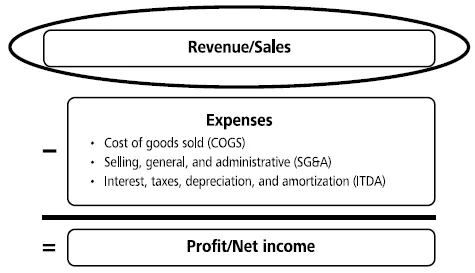![]()
BENEFIT 1
Increased Revenue and Market Share
Think about sustainability as the common ground shared by your business interests (those of your financial stakeholders) and the interests of the public (your nonfinancial stakeholders). This common ground is what we call the sustainability sweet spot: the place where the pursuit of profit blends seamlessly with the pursuit of the common good.
— Andrew Savitz, The Triple Bottom Line
Revving-Up Revenue
A powerful rationale for sustainable development is enlightened self-interest, fed by the prospect of higher profits. Reducing expenses is one way to improve profits (and we quantify those possibilities in later chapters), but as the saying goes, you can’t save your way to prosperity. That is why business strategy is often driven by bolstering revenue more than by cutting costs. Accordingly, and following the flow of the income statement in Figure 2.1, the first sustainability benefit we examine is increased revenue and market share.
In the Introduction we discussed how sustainable enterprises handle the tricky issues of growth and overconsumption. Sustainable enterprises disconnect revenue growth from depletion of natural resources by drastically reducing the amount of natural resources required to make their products and by using resource- and energy-efficient manufacturing processes. They decouple revenue growth from waste, pollution, and the depletion of natural capital by taking back their products at the end of their useful lives and ensuring they are responsibly disposed of, or reused.
Markets are fickle. Societal expectations change. Companies should anticipate those changes and develop new practices, new products, new markets, and new services in advance. Doing this before competitors do is the key to revenue growth and to sustained profits. However, when market leaders take action, their competitors often follow suit. The half-life of competitive differentiation is becoming shorter as reverse engineering and corporate intelligence improve. As soon as competitors have similar responsible practices and offerings, any competitive advantage is lost. Companies must continuously innovate to maintain their leadership position.
In this chapter we look at three innovative revenue streams that help ensure higher profits for sustainability leaders.
1.More business-to-consumer (B2C) and business-to-business (B2B) revenue from a more sustainable brand
2.New revenue from new green products
3.New revenue from services and leasing
| | FIGURE 2.1 |
| Income Statement Framework |
| |
More B2C and B2B Revenue from a More Sustainable Brand
Asustainable brand makes a difference in the B2C sector. Increasingly, people prefer to do business with companies that are doing good things and are responsible. The responsible image of the company builds loyalty with customers who identify with the values of the company — such customers are more loyal to the company than to its products. Even when buying green products, consumers may gravitate toward buying from companies that best walk-the-talk on sustainability at a corporate level.
There are many ways a company can improve its image as a responsible corporate citizen. It can lighten its carbon footprint by using less energy from fossil fuels. It can conserve water to ensure the most precious natural resource on the planet is available for future generations. It can enforce strict sustainability standards for suppliers. It can be a better steward of its waste. It can “green” its buildings. It can respect employees and support communities.
These are all company-level initiatives. The company is still producing the same products, but it has improved its overall track record and polished its image as an entity that cares about society’s environmental and social challenges. Consumers who share those concerns are more inclined to do business with kindred corporate spirits.
Within the last three years there has been growing evidence that a company’s sustainability image is important in the B2B sector as well. In 2010, Walmart’s bellwether 15-question survey of its 100,000 suppliers (see Figure 2.2) was a clear signal that the sustainability of a company’s operations makes a difference to its corporate customers.
Suppliers can capitalize on this huge B2B market if their operations and products satisfy their business customers’ sustainability criteria, especially if their competitors’ do not. As a company pays attention to the life-cycle footprints of its products and reduces its social and environmental impacts, it earns the right to be retained as a valued member of its current customers’ sustainable supply chains. If competitors are dropped from their customers’ supply chains because they are sustainability laggards, more sustainable companies can pick up that business.
Gaining B2C and B2B revenue from a more responsible brand is the first of three ways that sustainability strategies bolster revenue. Next, we’ll look at new revenue from new green products.
| | FIGURE 2.2 |
| Walmart’s Supplier Sustainability Index |
| Energy and Climate 1.Have you measured your corporate greenhouse gas emissions (GHGs)? 2.Have you opted to report your GHGs to the Carbon Disclosure Project (CDP)? 3.What is your total annual GHGs reported in the most recent year measured? 4.Have you set publicly available GHG reduction targets? What are they? Material Efficiency 1.What is the total amount of solid waste from facilities that produce product(s) for Walmart in the m... |



